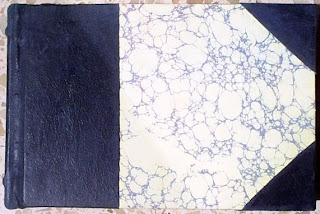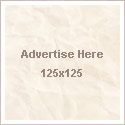

Bookbinding is a Bookbinding is the process of physically assembling a book from a number of folded or unfolded sheets of paper or other material. It usually involves attaching covers to the resulting text-block.
Origins of the book
The craft of bookbinding originated in India, where religious sutras were copied on to palm leaves (cut into two, lengthwise) with a metal stylus. The leaf was then dried and rubbed with ink, which would form a stain in the wound. The finished leaves were given numbers, and two long twines were threaded through each end through wooden boards. When closed, the excess twine would be wrapped around the boards to protect the leaves of the book. Buddhist monks took the idea through Persia, Afghanistan, and Iran, to China in the first century BC.
Hardcover binding
A hardbound book has rigid covers and is stitched in the spine. Looking from the top of the spine, the book can be seen to consist of a number of signatures bound together. When the book is opened in the middle of a signature, the binding threads are visible. Signatures of hardcover books are typically octavo (a single sheet folded three times), though they may also be folio, quarto, or 16mo. Unusually large and heavy books are sometimes bound with wire.
Methods of hardcover binding
There are a number of methods used to bind hardcover books, from them:
- Oversewing, where the signatures of the book start off as loose pages which are then clamped together. Small vertical holes are punched through the far left-hand edge of each signature, and then the signatures are sewn together with lock-stitches to form the text block. Oversewing is a very strong method of binding and can be done on books up to five inches thick. However, the margins of oversewn books are reduced and the pages will not lie flat when opened.
- Sewing through the fold, where the signatures of the book are folded and stitched through the fold. The signatures are then sewn or glued together at the spine to form a text block. In contrast to the previous method, through-the-fold books have wide margins and can open completely flat. However, the text block of a sewn-through-the-fold book is not very secure, which can cause some signatures to come loose over time. Many varieties of sewing stitches exist, from basic links to complex decorative stitches. While Western books are generally sewn through holes punched along the fold, some Asian bindings, such as the Retchoso or Butterfly Stitch of Japan, use small slits instead of punched holes.
- Double-fan adhesive binding starts off with two signatures of loose pages, which are run over a roller--"fanning" the pages—to apply a thin layer of glue to each page edge. Then the two signatures are perfectly aligned to form a text block, and glue edges of the text block are attached to a piece of cloth lining to form the spine. Double-fan adhesive bound books can open completely flat and have a wide margin. However, certain types of paper do not hold adhesive well, and, with wear and tear, the pages can come loose.
Punch and Bind
Different types of the punch and bind binding include:
- Wire binding is the type of binding that is used for books that will be viewed or read in an office or home type environment. The binding involves the use of a "C" shaped wire spine that is squeezed into a round shape using a wire closing device. Double wire binding has a nice look, allows books to have smooth crossover and is affordable in many colors. This binding is great for annual reports, owners manuals and software manuals. Wire bound books are made of individual sheets, each punched with a line of round or square holes on the binding edge. This type of binding uses either a 3:1 pitch hole pattern with three holes per inch or a 2:1 pitch hole pattern with two holes per inch. The three to one hole pattern is used for smaller books that are up to 9/16" in diameter while the 2:1 pattern is normally used for larger books as the holes are slightly bigger to accommodate slightly thicker, stronger wire. Once punched, the back cover is then placed on to the front cover ready for the wire binding elements (double loop wire) to be inserted. The wire is then placed through the holes. The next step involves the binder holding the book by its pages and inserting the wire into a "closer" which is basically a vise that crimps the wire closed and into its round shape. The back page can then be turned back to its correct position, thus hiding the spine of the book.
- Comb Binding uses a 9/16" pitch rectangular hole pattern punched near the bound edge. A curled plastic "comb" is fed through the slits to hold the sheets together. Comb binding allows a book to be disassembled and reassembled by hand without damage. Comb supplies are typically available in a wide range of colors and diameters. The supplies themselves can be re-used or recycled. In the United States, comb binding is often referred to as 19-ring binding because it uses a total of 19 holes along the 11-inch side of a sheet of paper.
- VeloBind is used to permanently rivet pages together using a plastic strip on the front and back of the document. Sheets for the document are punched with a line of holes near the bound edge. A series of pins attached to a plastic strip called a Comb feeds through the holes to the other side and then goes through another plastic strip called the receiving strip. The excess portion of the pins is cut off and the plastic heat-sealed to create a relatively flat bind method. VeloBind provides a more permanent bind than comb-binding, but is primarily used for business and legal presentations and small publications.
- Spiral binding is the most economical form of mechanical binding when using plastic or metal. It is commonly used for atlases and other publications where it is necessary or desirable to be able to open the publication back on itself without breaking the spine. There are several types but basically it is made by punching holes along the entire length of the spine of the page and winding a wire helix (like a spring) through the holes to provide a fully flexible hinge at the spine. Spiral coil binding uses a number of different hole patterns for binding documents. The most common hole pattern used with this style is 4:1 pitch (4 holes per inch). However, spiral coil spines are also available for use with 3:1 pitch, 5:1 pitch and 0.400-hole patterns.
- Proclick (GBC) is a relatively new binding style that was originally designed for use with a 3:1 pitch wire binding hole pattern. This type of binding uses an element that snaps shut and can be easily opened for editing purposes. The editing abilities of this style make it popular with direct sales organizations and mobile offices.
- ZipBind the binding spines for this style are designed to work with the 9/16" plastic comb binding hole pattern. Like Proclick, Zipbind spines can easily be opened and closed without the need for a binding machine. Thus the addition and deletion of pages is a simple process provided that the pages have already been punched.
Thermally activated binding
Some of the different types of thermally activated binding include:
- Perfect binding is often used, and gives a result similar to paperback books. They usually consist of various sections with a cover made from heavier paper, glued together at the spine with a strong flexible glue. The sections are rough-cut in the back to make them absorb the hot glue. The other three sides are then face trimmed. This is what allows the magazine or paperback book to be opened
- Thermal Binding uses a one piece cover with glue down the spine to quickly and easily bind documents without the need for punching. Individuals usually purchase "thermal covers" or "therm-a-bind covers" which are usually made to fit a standard size sheet of paper and come with a glue channel down the spine. The paper is placed in the cover, heated in a machine (basically a griddle), and when the glue cools, it adheres the paper to the spine. Thermal glue strips can also be purchased separately for individuals that wish to use customized/original covers.
- A cardboard article looks like a hardbound book at first sight, but it is really a paperback with hard covers. Many books that are sold as hardcover are actually of this type. This type of document is usually bound with thermal adhesive glue using a perfect binding machine.
- Tape Binding refers to a system that wraps and glues a piece of tape around the base of the document. A tape binding machine such as the Powis Parker Fastback or Standard Accubind system will usually be used to complete the binding process and to activate the thermal adhesive on the glue strip. However, some users also refer to Tape Binding as the process of adding a colored tape to the edge of a mechanically fastened (stapled or stitched) document.
- Unibind is a variety of thermal binding that uses a special steel channel with resin rather than glue inside of it to give it a more sturdy bind to hold the pages in place. Unibind can be used to bind soft covered documents with a look that is similar to perfect binding. It can also be used for binding hardcover books and photo books. Like Thermal Binding, unibind usually requires you to purchase a one piece coverset to bind your documents. However, Unibind also offers SteelBack spines that allow you to use your own covers in the binding process. The majority of Unibinds covers can be printed on as well to give documents a unique finish.
Stitched or Sewn Binding
Types of stitched or sewn bindings:
- A sewn book is constructed in the same way as a hardbound book, except that it lacks the hard covers. The binding is as durable as that of a hardbound book.
- Stapling through the centerfold, also called saddle-stitching, joins a set of nested folios into a single magazine issue; most American comic books are well-known examples of this type.
- Magazines are considered more ephemeral than books, and less durable means of binding them are usual. In general, the cover papers of magazines will be the same as the inner pages (self-cover) or only slightly heavier (soft cover). Most magazines are stapled or saddle-stitched; however, some are bound with perfect binding and use thermally activated adhesive.
Modern hand binding by hand can be seen as two closely allied fields: the creation of new bindings, and the repair of existing bindings. Bookbinders are often active in both fields.








0 comments:
Post a Comment